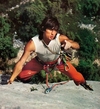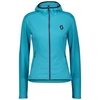Michel Piola interview: climbing on Mont Blanc, the search and the story that continues
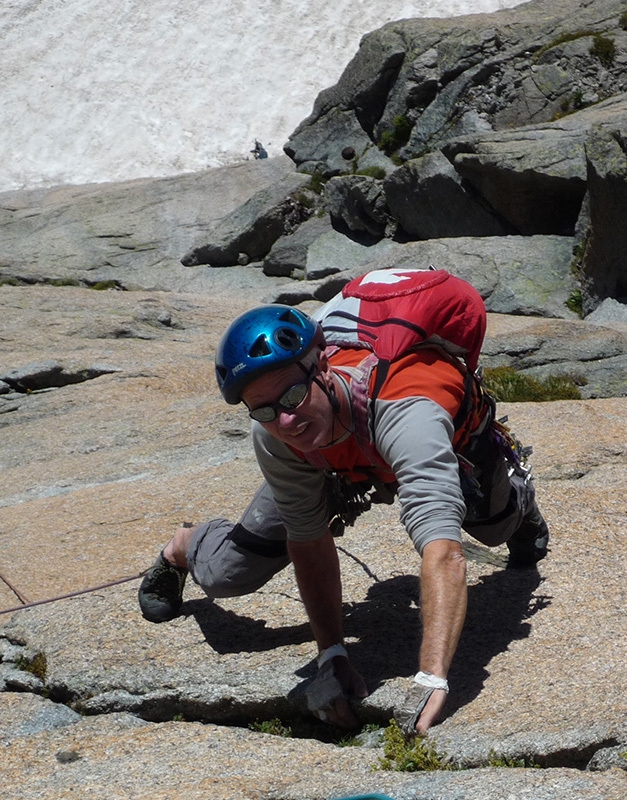
 1 / 6
1 / 6 Pascal Strappazzon e Vincent Sprüngli
Pascal Strappazzon e Vincent Sprüngli
Maurizio Oviglia
Michel, I'd like to ask you some questions about Envers des Aiguilles, the fantastic climbing paradise on the Aiguilles des Chamonix. You and your friends began establishing new routes on these faces more or less 30 years ago. Was there a specific plan? Did you imagine at the time what it might become?
It was the summer of 1982 and I was making my way back from the south Face of the Fou, this was the first time I'd been to Envers des Aiguilles and I couldn't believe my eyes. There were literally dozens of blank faces and spurs ...
At that time – just like nowadays sometimes – no one claimed that there was nothing left to do in the Alps, all you had to do was look upwards...
Without wishing to make any major statement, but seeing that this Eldorado was there for all to see, I immediately thought that this side of the Aiguilles de Chamonix would become one of the greatest granite climbing areas of all.
What role did routes like Voyage Selon Gulliver on Gran Capucin play in determining the ethics you later applied to the Envers? Did you consciously search for a more playful, less alpine approach, or was there no underlining basic philosophy for your first ascents?
There is a no huge difference between the Grand Capucin and the 500 or 800 metre high "big walls" on the Envers des Aiguilles... The altitude perhaps, but days on the Envers often end up in the shade, the glaciers are just as crevassed , and the approach isn't carried out on skis from the cable car. The routes close to Aiguille du Fou and Aguille de la République will always remain isolated and challenging! Actually quite the opposite holds true, I'd say we applied what we did on Envers des Aiguilles to the Grand Capucin, without any significant differences.
So, no, you can't really state that the Envers offers less "alpine" climbing than the Combe Maudite, at least as regards the long multi-pitches. Put simply, the Envers des Aiguilles offers perhaps a better choice of routes that allow for a gradual improvement, fortunately with some routes located close to the refuge, without a glacier approach and up excellent rock, that could be defined as "educational" or, I'll pass your term, "playful"…
What do the Envers des Aiguilles owe its success to? Mainly the bolts or other reasons, too? How did you arrive at making those ethics that, over time, have become true clichés?
You mention the word "cliché" perhaps because you want to say that the "modern" climbs in the Mont Blanc massif are full of bolts? Yet the (silent) vast majority of climbers who have repeated these routes believe that there are very few bolts, in particular on the compact slabs that host the routes put up in the 1980's, where failing to clip them would lead to very long, at times life-threatening falls. No, believe me, the real ethical choice that revolutionised climbing in the mountains is the systematic use of bolted belays, even on crack climbs, as these guarantee a retreat by abseil at any given moment. Since then, the spirit of mountain climbing, and in particular the acceptance of risk, has changed radically. That is why some may believe that there is an over-abundance of bolts, but I reject this theory outright and remain convinced that the idea of "semi-trad" (bolted belays, clean cracks) is the only viable way forward to ensure the future of granite climbing.
Everyone is capable of making a solo ascent 2 or 3 grades easier their usual grade, even a sharp flake 5 meters below is feasible for someone repeating a climb, not so for the first ascentionists who don't want their nights tormented by ghosts...
Let's put the church back in the centre of the village: at the Envers, just like everywhere else in the massif, bolts that have been placed are essential (try to repeat Monsieur de Mesmaeker on Aiguille du Midi without them!), sometimes they enable you to avoid weaving, ugly lines across unsafe ledges or flakes. Sometimes, on rare occasions, they even help show the way.
To guarantee this "sport" spirit I famously campaigned against the first ascents in the mountains bolted from above (it's worth remembering that this protest movement came about during from 1985 – 90) and, at a later date, the overuse of bolts that came hand-in-hand with the cordless drill.
I remember I was perhaps one of the first Italians to repeat your routes during that era. The hut warden was Babette, she was always very kind to us climbers. She kept a new routes book, with all the statistics of the various repeats. What do you remember of those days? And are you still in touch with Babette?
We write each other letters: Babette was a great personality in the Chamonix valley, her mentality was new and open towards the climbs. Envers des Aiguilles owes much of its success to her!
Folies Bergeres was considered one of the most difficult routes at that time, a masterpiece of slab climbing. Some of my friends ried to repeat it, a real odyssey! I remember hearing legends about the first ascent on these slabs, can you share some stories with us?
Yes, it's true, that first ascent roved somewhat difficult: we were certainly at the top of slab "specialization" game (so much so that we weren't much good at climbing other styles) but at the same time we really reached our limit, especially if you think that we made the first ascent with a hand drill! My best memories are connected to routes that really "develop", crack climbs such as Une gueule du diable” or “Pedro-polar” and above all routes higher than 500m: “Oublie ta vie”, “République bananière”, “Subtilités dülfériennes”, etc…
What do you feel were the best achievements of that era, or which do you have particularly fond memories of?
I have a soft spot for all first ascents up virgin faces, routes where no other line nearby were the reason for them being established as they were. There are dozens like this on the Envers des Aiguilles, and I realise that, as a first ascentionist, I've been lucky. Having said that, I still continue to find virgin faces nearly every summer in this limitless Mont Blanc massif.
Envers des Aiguilles today. You once confided that you spend much time rebolting the routes of that era. How important for you is this inheritance?
Fundamentally a first ascentionst must be altruistic, and at a later stage deal with the safety and maintenance of the routes. So yes, I reequip practically everything I've climbed, for the last 10 years only with resin bolts, even up the mountains.
In this regard, I'd like first ascentionists and those who rebolt routes to really be aware of their responsibility. It's important that they no longer use stainless steel bolts and hangers which become loose and require continuous maintenance (my biggest regre at Envers is that we started too early and weren't able to rebolt everything with glue-in bolts). Since the start of the new millennium, with the "removable bolts" technology, one can establish new routes ground-up almost everywhere with glue-in bolts, and I honestly don't understand why I'm one of the only climbers in Europe who has opted for this style.
Are you worried that some beautiful routes might fall into oblivion if people don't think about rebolting them?
The beautiful, not too extreme routes have been and will be re-equipped, the hardest routes will eventually disappear from our collective memory... and, all things considered, this isn't a big loss!
Is the Envers still a reference point for the Mont Blanc massif nowadays? How do the new generations of climbers approach these routes?
The most important factor that contributes to the success is the hut, the Envers des Aiguilles refuge, comfortable, cozy and far less expensive than the tickets for the Aiguille du Midi and Punta Helbronner cable cars. But success is certainly also due to the incredible number of routes close to the hut that enable climbers to make the most of the days at their disposal. It feels as if you're bivying at the base of the mountain faces, without ever feeling "cut off" from the outer world by the granite as is often the case at other mountain huts. The hut at Envers des Aiguilles is like an eagle's nest, sat on a rocky outcrop 50m above the last grassy slopes, but on the eastern ridge of Tour Verte; this position is almost unique for a large hut in the Alps. There will always be climbers who love this special atmosphere and the fact that one can reach numerous climbs without having to cross the glacier, an "approach" which can feel somewhat nerve-wracking for semi-trad climbing.
Seeing the recent return to trad climbing, do you still think you made the right choices back then? Or would some routes, were they to be climbed today for the first time, would they be established differently?
For the vast majority of climbers there is no return to the "trad" ethics. Everyone is increasingly steering towards fully-equipped routes and the tiny elite establishing trad routes is not representative. If one were to (re) discover the Envers today, I am certain that the first ascentionists would compete against each other to place more bolts, instead of making trad climbs.
We need to understand what the term "trad" means (pure trad?), a style that tends to disappear, clearly due more to the bolt belays on historic routes, which I view as really ominous, rather that to a corner of the Mont Blanc massif dedicated to "modern" (in semi-trad...) routes. It seems to me as if they seek to preserve this style of climbing. Envers des Aiguilles, in this dispute, is the best argument.
by Maurizio Oviglia



 Copia link
Copia link

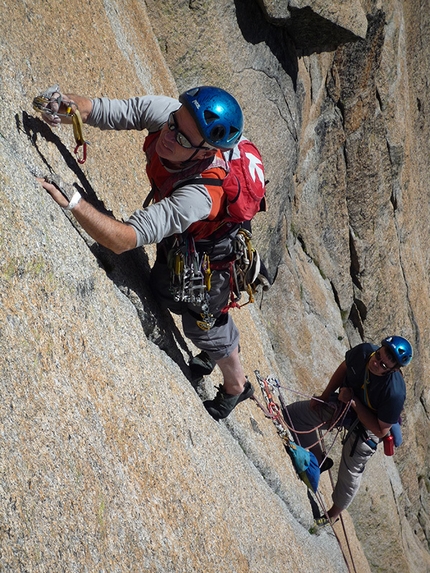
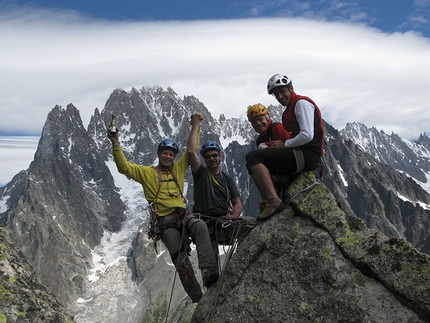
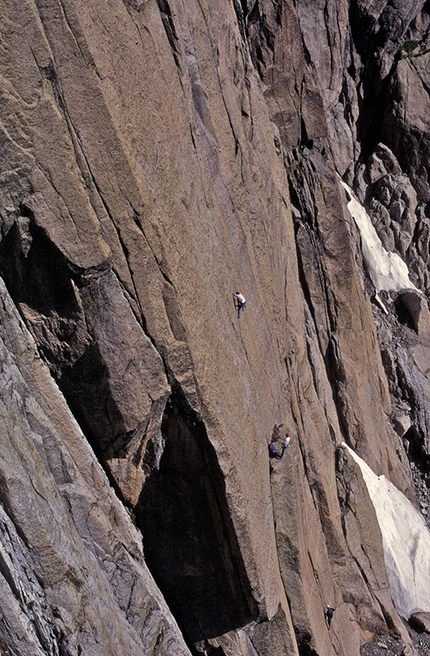
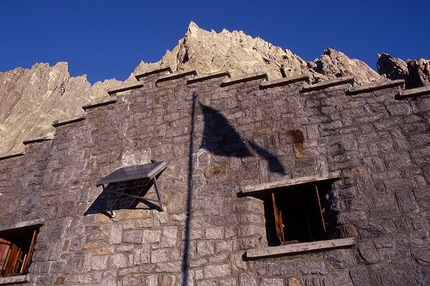
 See all photos
See all photos